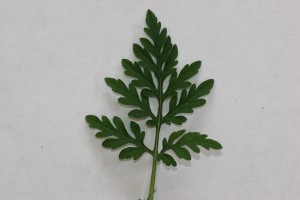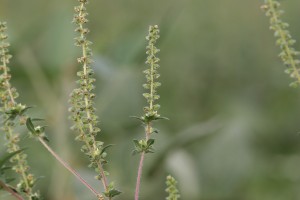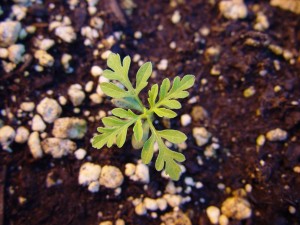
Common ragweed – Ambrosia artemisiifolia
Ambrosia artemisiifolia L.
Asteraceae (Aster family)
MI Status
Native
Life cycle
Erect, branching summer annual.
Leaves
Cotyledons are thick and oval to spatula-shaped. Leaves are fernlike, once or twice compound and usually hairy. Upper leaves are alternate; lower leaves may be opposite or alternate with distinct petioles.
Stems
Usually hairy, erect and branched up to 6 feet tall.
Flowers and fruit
Flowers are generally inconspicuous, found on terminal branches. They produce prolific amounts of pollen. The seed is enclosed in a single-seeded, woody fruit with several spikes resembling a crown.
Reproduction
Seeds.
Similar weeds
Giant ragweed (A. trifida L.)
Differs by having cotyledons three to four times larger; three- to five-lobed leaves opposite in arrangement; and a height that may reach 15 feet.
Western ragweed (A. psilostachya DC.)
Differs by having a perennial nature with prolific creeping roots, densely hairy leaves and a height typically not above 4 feet.



Other Documents in this Series
You Might Also Be Interested In
-
Hands-on calf care training series offered
Published on April 26, 2019
-
Newborn Calf Care Management - English and Spanish
Published on May 5, 2022
-
Water for calves is important
Published on June 15, 2022
-
Important changes to note in the dairy calf and heifer association’s 2020 gold standards
Published on July 8, 2022
-
Beef calf weaning management to prepare your calves for future success
Published on July 26, 2022
-
Healthy Births, Healthy Calves: Managing Parturition, Dystocia, and Newborn Calf Care
Published on March 3, 2025
Accessibility Questions:
For questions about accessibility and/or if you need additional accommodations for a specific document, please send an email to ANR Communications & Marketing at anrcommunications@anr.msu.edu.



 Print
Print Email
Email



